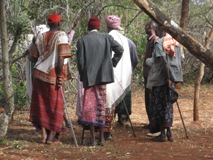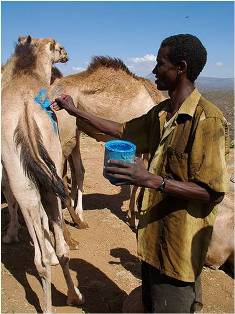 The research focus of this project has been to explore and critically assess pastoralist innovation systems.
The research focus of this project has been to explore and critically assess pastoralist innovation systems.
There has been very little literature on innovation in the livestock sector and a particular lack of knowledge on innovation involving pastoralists. Existing formal innovation systems in the livestock sector emphasise the development of new technology and knowledge by scientists, such as cross-breeding livestock and improving methods of artificial insemination, reflecting a bias toward ranching and commercial beef production.
Policy briefing
Innovation works: pastoralists building secure livelihoods in the Horn of Africa (download PDF)
More about the project
Innovation is often thought of as a kit encompassing inputs and extension services that draw upon scientific knowledge and technology developed by national and international agriculture research bodies. This research, however, understood innovation differently: as something involving institutional, social and cultural changes that happen alongside formal scientific and technological development, such as shifts in tenure and access structures, social organisation and gender norms and relations. Innovation is not only happening in universities and national and international research organisations. There is considerable innovation happening in pastoralist areas but it is not documented or understood except by the people doing it. Many pastoralist innovations remain ‘hidden’, ‘under the radar’ and hence are poorly understood.
The reasons why pastoralists are innovating, what they are doing, who is innovating and what are the outcomes of innovations is unknown. Pastoralists are not rejecting new technology; rather they are themselves innovators who create new institutions, tenure arrangements, and ways of social organisation and resource use to better manage new pressures as well as take advantage of opportunities.
Conventional research and development systems for innovation are not responding to pastoralist innovations and are largely disconnected from these. This mismatch between formal and informal innovation systems is one reason why many formal innovations are not working for pastoralists because they are leading to the development of inappropriate technologies. Therefore, a key challenge and question for this project was how and in what ways formal and informal innovation systems can be brought together.
Geographical Focus
The geographic focus of this research was northern Kenya and southern Ethiopia, where a variety of pressures and drivers are causing significant changes in pastoralist production systems. These include the opening of livestock markets in the Arabian peninsula, restrictions on mobility and access to high quality fodder for supporting mixed-species herds, and land grabs to support the expansion of irrigated farming schemes for commercial agriculture. Pastoralists are responding to the risks and opportunities presented by these changes in new and important ways that warrant investigation in their own right.
Methodology
The research was based on case studies of distinct pastoralist innovations.
Kenya Case Study 1 Northern Kenya pastoralists and Ethiopian camel markets
 We examined a range of adjustments that pastoralists were making in northern and north-eastern Kenya in response to the opening of camel markets in Ethiopia, where a ranch and abattoir was opened in recent years to supply markets in the Arabian peninsula. Increasingly northern Kenya pastoralists were marketing their camels through Ethiopia to benefit from this new marketing opportunity as opposed to selling their camels in Kenya, where the domestic market for camel meat was small and prices were correspondingly low.
We examined a range of adjustments that pastoralists were making in northern and north-eastern Kenya in response to the opening of camel markets in Ethiopia, where a ranch and abattoir was opened in recent years to supply markets in the Arabian peninsula. Increasingly northern Kenya pastoralists were marketing their camels through Ethiopia to benefit from this new marketing opportunity as opposed to selling their camels in Kenya, where the domestic market for camel meat was small and prices were correspondingly low.
Kenya Case Study 2 – Grazing patterns in Tana River valley
We examined changing grazing patterns associated with new leasing arrangements for land. Large swathes of land in the Tana River valley, which is a key resource area for pastoralists, have been ‘grabbed’ to develop large irrigation schemes for industrial-scale farming. As grazing resources become more constrained because of these developments, new tenure, institutional and marketing arrangements are emerging as pastoralists seek new ways of accessing high value fodder that is required for fattening animals. Livestock are being driven from Northeastern Province to private ranches in Coast Province and as far away as Taita. Herders pay a monthly fee to graze their livestock on these ranches. The case study explored this and other ways in which pastoralists are accessing fodder and water in response to new constraints.
Kenya Case Study 3 – Increasing access to high value fodder in Lakipia District
Our research examined other pastoralist innovations to increase access to high value fodder in Lakipia District bordering Mt. Kenya, as well. During the recent severe drought that affected the region in 2009, pastoralists sought to access fodder in the Mt. Kenya forest. However, although herders are permitted access to the forest, the Kenyan government prohibits pastoralists from staying overnight. Pastoralists formed agreements with farmers bordering the forest to kraal their livestock at night on farms so that they could access the forest during the day. Herders also negotiated access to the many private wildlife conservancies in the district, where they kept livestock for fattening. Some conservancies have also constructed small abattoirs to provide a market outlet for animals that have been fattened on conservancies. The research examined these and other pastoralist innovations in response to a scarcity of high value fodder.
Kenya Case Study 4 – Pastoralist responses to the mysterious camel disease
Research in Kenya also documented how pastoralists responded to a mysterious camel disease that swept northern Kenya in 2007 and 2008. The disease mystified veterinarians and community animal health practitioners. Pastoralists used drugs developed for cattle to treat the diseased camels. The disease eventually disappeared, but it is unclear why. The case study aimed to give insights into how pastoralists innovate in response to a lack of investment into the requirements of diagnosing and treating camel diseases, in spite of their growing economic value. This is important in view of how camels might weaken and become even more disease-prone as the condition of rangelands deteriorates and constraints on mobility grow.
Ethiopia Case Study 5 – Trends in marketing camel milk
In Ethiopia, we examined trends in marketing camel milk. Increasingly pastoralists are keeping camels nearer to towns to supply milk to growing urban markets. Customarily, most milk from camels was used for households’ own consumption. The research assesses adjustments pastoralists are making to take advantage of these emerging market opportunities, including changes in social organisation to accommodate keeping camels near urban settlements over long periods, and how herders support the fodder requirements of camels kept by towns.
Ethiopia Case Study 6 – Pastoralists response to rangeland enclosures
In Ethiopian, we looked at pastoralist responses to rangeland enclosures and changing land tenure and use. The growing prevalence of enclosures, including those near to towns where herd owners hire grazing for fattening livestock, has a number of implications for grazing patterns, mobility, social organisation and rights to animals. Private landowners that lease grazing rights to pastoralists acquire the rights to offspring of livestock that are grazed on their holdings. Yet pastoralists continue to graze these livestock with their own herds and benefit from the products from these animals when they are grazed away from towns. The need to access high quality fodder is causing other changes that were looked at in the research, including increasing linkages between highlands and lowlands to supply fodder markets in pastoralist areas during droughts and the dry season.
Bilateral Case Study 7 in Ethiopia and Kenya – Innovations in peace and security
In recent years in Northern Kenya and Southern Ethiopia, violent incidents have claimed increasing numbers of lives. Incidents of political intimidation, cattle rustling, smuggling and other kinds of crime have spread fear, disrupted trade, hampered livestock production and impeded mobility. In a climate of political instability and judicial incapacity in the unruly borderlands of East Africa, a small but nonetheless significant number of young pastoralists, entrepreneurs and officials have gained power and wealth.
Pastoralist citizens hoped that government and NGO promises of peace and investment would be successful. But as the situation worsened, they began to discuss new ways of tackling the problem. They argued that no beneficial innovation in the rangelands, the markets or any part of pastoralist life could happen while this level of violence prevailed.
Over a period of seven years the innovation has gradually expanded. At first individual traditional leaders worked on discrete interventions. Today’s work involves interconnected efforts by a coalition of pastoralists and others, affecting whole conflict systems. Pastoralist capabilities to maintain peace are being developed in contemporary conditions. While innovative, their work is anchored in tradition: in pastoralist culture, law, religion and understanding. Linking old and new forms of authority, they are experimenting with bringing together customary and state law in a basic framework of acceptable justice. It includes a wide range of people, young and old, women and men, peace makers and trouble makers.
Pastoralist elders in northern Kenya and southern Ethiopia designed a study for the Future Agricultures research programme looking at what is making this particular innovation work. Their study tracked the development of the new peacemaking approach and outline how the innovation is unfolding. The focus is on a peace process between the Gabra and Borana of Kenya and Ethiopia. It looks at the actors and their actions, knowledge, powers, connections and differences. It clarifies the systems that limit and define the innovation and shape it as time goes on. It takes account of the political and cultural reasons that agreements and disagreements unfold as they do. (Read more about this process.)
Pastoralist Shade Initiative
The Pastoralist Shade Initiative is an organisation formed by Kenyan pastoralist elders from eight different ethnic groups. Created in 2008 in response to increasing levels of conflict and failures of mainstream development to address pastoralist issues, its aim is to “bring together pastoralist communities in an inclusive process that engages with government and other actors to achieve and maintain peace using traditional conflict resolution methods”. PSI is to carry out the research under the bilateral Case Study 7.
{jathumbnail off}
